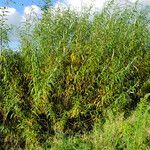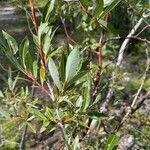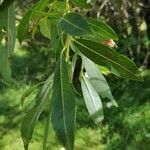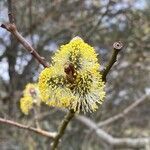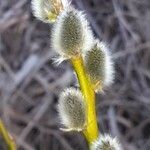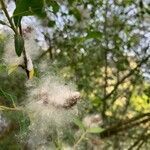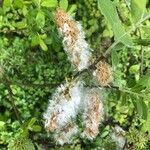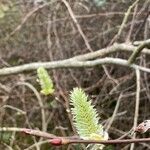Stems: branches red-brown, strongly glaucous (losing glau-cescence in age but remaining so at nodes), glabrescent; branchlets yellow-brown, (not glaucous, except in age), usually glabrescent, sometimes sparsely or moderately densely tomentose. Leaves: stipules (often adnate to petioles), usually rudimentary on early ones, late ones lanceolate to ovate, apex acuminate or acute, often adnate to petiole; petiole shallowly grooved, or convex to flat adaxially, 5-18 mm, tomentose to glabrescent adaxially; largest medial blade oblong, lorate, narrowly elliptic, or elliptic, 50-96(-120) × 1-35(-40) mm, base cuneate to concave, margins slightly revolute, serrate to crenate, apex acuminate, abaxial surface glaucous, glabrescent or midrib sparsely tomentose, hairs (white, sometimes also ferruginous), spreading, straight, long or short, adaxial slightly glossy, (midrib sparsely tomentose or throughout); proximal blade margins entire, closely gland-dotted; juvenile leaves green, sparsely to moderately densely long-silky abaxially, hairs white, sometimes some ferruginous. Catkins flowering before or just before leaves emerge; staminate stout, 30-47 × 9-20 mm, flowering branchlet 0-1.2 mm; pistillate densely flowered, stout, 20-50 mm, flowering branchlet ca. 1.5 mm; floral bract dark brown or bicolor, 2.8-3 mm, apex acute to convex, moderately densely hairy throughout, hairs straight. Staminate flowers: adaxial nectary narrowly oblong to flask-shaped, 0.5-1 mm; filaments distinct or connate basally; anthers purple turning yellow, short-to long-cylindrical or ellipsoid, 0.5-0.7 mm. Pistillate flowers: adaxial nectary oblong to square, 0.4-0.9 mm; ovary pyriform, beak gradually tapering to styles; ovules 4-6 per ovary; styles 0.6-1.5 mm. Capsules 3.2-4.4 mm. 2n = 38.
More
Small tree to c. 10 m high; ultimate branches ± pendulous; bark somewhat rough towards base. Shoots dark, with glaucous-white bloom in first 1-3 years, rather brittle, lacking striations below bark; buds glaucous, densely hairy. Petiole 1-2 cm long. Lamina 5-18 × 0.7-3 cm, usually linear-lanceolate, green, glaucescent or glaucous below, shining above, soon glabrous, bitter to taste, glandular-serrulate, slightly undulate; apex acuminate. Stipules 0.5-2 cm long, lanceolate. Catkins ?, mainly appearing before lvs, 3-5-(6) cm long, broad-cylindric, ± erect; rachis villous. Bracts 1-3.5 mm long, ovate or subovate, black in upper 3/4 or more, silky hairy; apex acuminate. Gland 1, 0.2-1.2 mm long, narrow-cylindric. Stamens 2, glabrous; anthers yellow.
A shrubby deciduous tree. It grows 10 m tall. It is a broad cone shape. The bark is grey and smooth. The leaves are narrow and 6-12 cm long by 3 cm wide. They taper to a point. There are fine teeth along the edges. The leaves are glossy dark green above and blue-green underneath. They have hairs on both sides but become smooth. The male and female flowers are separate. They are very small. They are in catkins 4 cm long. The fruit is a small green capsule. It opens to release fluffy seeds.
Montane river banks and riverine scrub in alpine areas on sandy, pebbly and bouldery alluvia, often together with Salix elaeagnos and Myricaria germanica. Sometimes descending to lowlands along large rivers, and also found on loose dune sand
More
It is a temperate plant. It is native to Europe. It grows in mountainous regions in Europe. It grows on dry sites. It suits hardiness zones 5-10.
